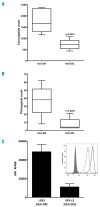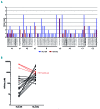Comparative profiling of HLA-DR and HLA-DQ associated factor VIII peptides presented by monocyte-derived dendritic cells
- PMID: 29025906
- PMCID: PMC5777204
- DOI: 10.3324/haematol.2017.175083
Comparative profiling of HLA-DR and HLA-DQ associated factor VIII peptides presented by monocyte-derived dendritic cells
Abstract
The development of anti-factor VIII antibodies is a major complication of the treatment of patients with hemophilia A. Generation of high affinity anti-factor VIII antibodies is dependent on help provided by CD4+ T cells that recognize factor VIII-derived peptides presented on class II major histocompatibility complex on the surface of antigen-presenting cells. In order to identify the immune-dominant epitopes that can be presented to CD4+ T cells, we previously developed a mass spectrometry-based method to identify factor VIII-derived peptides that are presented on human leukocyte antigen (HLA)-DR. In the present work, we compared the repertoire of FVIII-derived peptide presented on HLA-DR and HLA-DQ. Monocyte-derived dendritic cells from nine HLA-typed healthy donors were pulsed with recombinant factor VIII. HLA-DR and HLA-DQ molecules were purified using monoclonal antibodies. Our data show that HLA-DQ and HLA-DR present a similar repertoire of factor VIII-derived peptides. However, the number of peptides associated with HLA-DQ was lower than that with HLA-DR. We also identified a peptide, within the acidic a3 domains of factor VIII, which is presented with higher frequency on HLA-DQ. Interestingly, this peptide was found to have a higher predicted affinity for HLA-DQ than for HLA-DR. Taken together, our data suggest that HLA-DQ participates in the presentation of factor VIII peptides, thereby contributing to the development of inhibitory antibodies in a proportion of patients with severe hemophilia A.
Copyright© 2018 Ferrata Storti Foundation.
Figures




Similar articles
-
FVIII peptides presented on HLA-DP and identification of an A3 domain peptide binding with high affinity to the commonly expressed HLA-DP4.Haematologica. 2025 Jun 1;110(6):1316-1327. doi: 10.3324/haematol.2024.286204. Epub 2024 Dec 12. Haematologica. 2025. PMID: 39665218 Free PMC article.
-
Mass spectrometry-assisted identification of ADAMTS13-derived peptides presented on HLA-DR and HLA-DQ.Haematologica. 2018 Jun;103(6):1083-1092. doi: 10.3324/haematol.2017.179119. Epub 2018 Mar 22. Haematologica. 2018. PMID: 29567779 Free PMC article.
-
Limited promiscuity of HLA-DRB1 presented peptides derived of blood coagulation factor VIII.PLoS One. 2013 Nov 14;8(11):e80239. doi: 10.1371/journal.pone.0080239. eCollection 2013. PLoS One. 2013. PMID: 24244658 Free PMC article.
-
Hunting down factor VIII in the immunopeptidome.Cell Immunol. 2016 Mar;301:59-64. doi: 10.1016/j.cellimm.2015.11.001. Epub 2015 Nov 5. Cell Immunol. 2016. PMID: 26610639 Review.
-
To serve and protect: The modulatory role of von Willebrand factor on factor VIII immunogenicity.Blood Rev. 2017 Sep;31(5):339-347. doi: 10.1016/j.blre.2017.07.001. Epub 2017 Jul 4. Blood Rev. 2017. PMID: 28716211 Review.
Cited by
-
Specificity of the T Cell Response to Protein Biopharmaceuticals.Front Immunol. 2020 Jul 22;11:1550. doi: 10.3389/fimmu.2020.01550. eCollection 2020. Front Immunol. 2020. PMID: 32793213 Free PMC article. Review.
-
Identification of Key Coagulation Activity Determining Elements in Canine Factor VIII.Mol Ther Methods Clin Dev. 2020 Jan 15;17:328-336. doi: 10.1016/j.omtm.2019.12.019. eCollection 2020 Jun 12. Mol Ther Methods Clin Dev. 2020. PMID: 32071925 Free PMC article.
-
Emerging Concepts in Immune Thrombotic Thrombocytopenic Purpura.Front Immunol. 2021 Nov 11;12:757192. doi: 10.3389/fimmu.2021.757192. eCollection 2021. Front Immunol. 2021. PMID: 34858410 Free PMC article. Review.
-
Donor-Derived Cell-Free DNA as a Marker for the Efficacy of Daratumumab in Patients With Antibody-Mediated Rejection Post-Heart Transplantation: A Case Series.Pediatr Transplant. 2025 Sep;29(6):e70168. doi: 10.1111/petr.70168. Pediatr Transplant. 2025. PMID: 40851173 Free PMC article.
-
Development of a novel fully functional coagulation factor VIII with reduced immunogenicity utilizing an in silico prediction and deimmunization approach.J Thromb Haemost. 2021 Sep;19(9):2161-2170. doi: 10.1111/jth.15413. Epub 2021 Jun 30. J Thromb Haemost. 2021. PMID: 34060724 Free PMC article.
References
-
- Fijnvandraat K, Cnossen MH, Leebeek FWG, Peters M. Diagnosis and management of haemophilia. BMJ. 2012;344:e2707. - PubMed
-
- Franchini M, Tagliaferri A, Mengoli C, Cruciani M. Cumulative inhibitor incidence in previously untreated patients with severe hemophilia A treated with plasma-derived versus recombinant factor VIII concentrates: a critical systematic review. Crit Rev Oncol Hematol. 2012;81(1):82–93. - PubMed
-
- Gouw SC, van den Berg HM, Fischer K, et al. Intensity of factor VIII treatment and inhibitor development in children with severe hemophilia A: the RODIN study. Blood. 2013;121(20):4046–4055. - PubMed
-
- Hay CRM, Palmer B, Chalmers E, et al. Incidence of factor VIII inhibitors throughout life in severe hemophilia A in the United Kingdom. Blood. 2011;117(23):6367–6370. - PubMed
MeSH terms
Substances
LinkOut - more resources
Full Text Sources
Other Literature Sources
Research Materials
Miscellaneous

